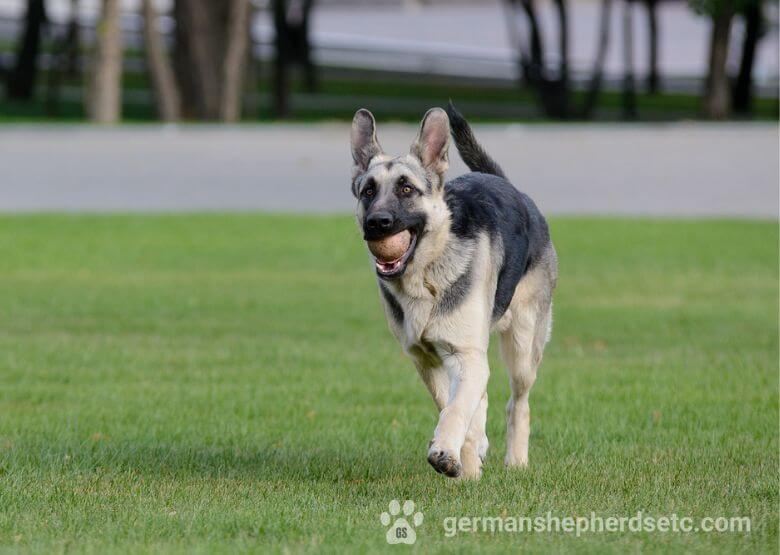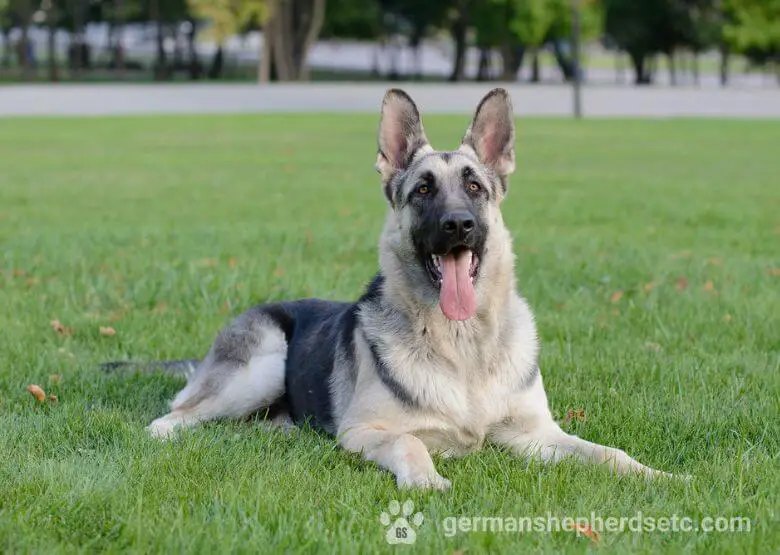Table of Contents
You may be interested in adopting a silver GSD because it seems unusual to you. However, the first thing you need to know is that silver Shepherds are very rare, and their fur coloration is not a sign of another breed but a result of color mutation, especially of red and tan hairs changing under the influence of certain genes or alleles. So, the dog’s coat may not necessarily be shimmering silver because the name of the color refers to any off-tan coloration.
You may have heard a lot about these unique dogs, but as long as some facts are true, others are absolute myths. So, let’s consider these doggies in more detail to know whether and how well you can deal with such a pup and its characteristic features.
History and Causes of Silver Color in German Shepherds
The history of this Shepherd coloring dates back to 1899, and this fur tint is considered to be the closest to the original German Shepherd. A German officer and veterinarian, Max von Stephanitz, spent about 35 years researching and breeding ideal herding dogs. Then, in 1899, a new breed was registered. It had a wolf-like appearance, was strong and alert, and was used as a working dog for herding sheep, serving in the police and military, and guarding.
After WWI, the breed was officially renamed to “Alsatian Wolf Dog,” and the animals with a specific diluted coloration got the name of a silver Alsatian dog after the province on the border between Germany and France. The change referred to political reasons, so in 1977, after numerous claims from dog breeders, the breed’s name was changed again to its original German Shepherd.
The German Shepherd breed became immensely popular in the USA. According to the American Kennel Club report, it was the third most registered breed in 2020. However, the AKC breed standards focus on rich colors, and washed-out tints that are undesirable for the show ring. Probably, it is one more reason why this coloring is so rare in GS dogs.
Therefore, how can this rare and unique color appear in German Shepherds? Every set of genes has two copies. They may be similar or different from each other. If they differ, one copy dominates and results in specific physical characteristics. The other copy produces recessive traits that are not physically displayed. However, these recessive traits can appear in further generations under specific conditions.
Both parents need to have a dilution recessive gene to receive a silver color. This gene called the KIT, influences the tan and red colors, making them cream or pale beige.
Another dilution gene is the Agouti or A-locus. It affects black, wild sable, and tan colors and also produces a silver coat hue. Therefore, silver refers to black or grey wold-like coat colors and any other diluted GS colors.
Appearance and Character of Silver German Shepherd Dogs

The appearance of a pure silver or black and silver German Shepherd does not differ much from the dogs of this breed with other colors. Such pups have a long muzzle, domed forehead, long bushy tail, black nose, and erect ears.
The average height of these male dogs is 24-26 inches (61-66 cm), and females are usually 22-24 inches (56-61 cm) tall. An adult male weighs 66-88 pounds (30-40 kg), while adult girls can weigh 49-71 pounds (22-32 kg).
The coat coloring varies – you can encounter silver-gray, black & silver, black & silver sable, and silver sable German Shepherd dogs. The type of coat is short-medium, medium, or long. The latter is pretty rare. Because these animals are double-coated, they are heavy shedders, especially in the seasons of spring and early autumn when they prepare for temperature changes.
Since silver Shepherds are a subtype of the mainstream breed, they have a build and physique fully identical to other German Shepherds. Their coloring ranges from cream to off-white with a metallic sheen. They usually have pure black spots among the silver areas. The size of the black areas depends on the color that the Agouti gene has diluted; for example, silver bi-color dogs are mostly black with minimal silver areas on saddles and blankets. It is a result of red or tan modifications.
As for their temperament, these pups do not differ much from their counterparts, either. They are brave, loyal, confident, and intelligent. Like other German Shepherds, they are alert, protective, energetic, and territorial. These pets are quite independent and versatile. They are aloof to strangers and can become superb family pets if properly trained. Socialized silver Shepherds are friendly to children and other pets in the household, and they can be perfect dogs for new owners.
Such dogs can work in the police, military, and search-and-rescue services. However, they bond with one person only, and it has to be taken into consideration while training to help them extend their protection drive to the entire team or household.
Silver Shepherds need a lot of exercise and a good trainer who is confident and consistent and applies only positive reinforcement. Individuals who are uncertain or not demanding cannot gain this dog’s respect, so it may start challenging them and breaking boundaries.
Since this German Shepherd coloring is rather rare, a puppy taken from a reputable breeder can cost $2,000-$2,500. The price depends on many factors, such as the litter size, breeder’s qualifications, health checks, and vet fees. Not every German Shepherd carries the Agouti gene that produces a silver coat. That makes the breeding process quite challenging and expensive. Moreover, even if both parents are the recessive gene carriers, they are not guaranteed to produce silver offspring. If you get only one silver puppy out of four in a litter or do not get any, the price of such a rare pup doggy will grow up.
How to Take Care of Your Silver GSD?
These dogs are not a mixed breed. They are purebred, with the same appearance, physical and behavioral patterns, and care needs as their counterparts. Though pure silver German Shepherd dogs are even rarer, most colors can get this stunning silver tint that differentiates this type of dog from other German Shepherds. Even the AKC accepts pure silver as a variation of registered colors. However, even if you register your doggy with this organization, it does not mean you can win prizes on most shows.
You may wonder whether your pet needs some specific care because of its coat color. In fact, there is nothing specific, though you need to consider the characteristics and requirements for this breed.
Nutrition is an important part of care, and feeding your doggy with high-quality kibble, a mixed diet, or a raw handmade diet rich in protein, fat, and useful carbs, is a must to preserve the shine of its fascinating silver coat.
Grooming is usually moderate – the common care for your pup’s nails, teeth, and ears. However, extensive brushing is recommended twice weekly, and you can do it even daily in shedding seasons.
Your pet will need a medium-to-high amount of exercise. Walking with your dog twice a day for at least 45 minutes per session will do a lot of good. As well, your doggy will need training and socializing. These pups are easy to train, and you can teach them a lot of commands.
The lifespan of a silver Shepherd is, on average, 10-13 years. You should practice regular visits to the vet to ensure your pet’s long and healthy years of life. Vaccination is also very important when you take a silver puppy home. Develop a schedule with your vet and accurately follow it.
Despite any misbeliefs, the coat color does not influence the overall health of silver Shepherds. They can suffer from common health problems among all other dogs of this breed. They are GDV (bloat), hip and elbow dysplasia, Von Willebrand’s disease, and degenerative myelopathy. You can prevent or manage many of these conditions if you provide your pet with proper care.

Myths and Misconceptions About Silver GS Dogs
The first misconception about silver German Shepherd dogs is that this color can affect the animal’s behavior. It is not true. The silver color is only a color variation, among many, that is not connected with any physical or mental features determining the dog’s temperament. However, some animals can be more aloof than others, while some individual dogs can be friendlier or more aggressive. Like all other German Shepherds, they need proper training and socialization. In addition, they do not like staying alone for a long time. They can get bored and destructive if you do not play or exercise with them. Try to include more problem-solving puzzles in the everyday training routine, and you will get a perfect pet and companion.
We have already mentioned that the coat color does not influence the dog’s health. Even the rarest blue-silver German Shepherd dogs can have the same issues as their red, tan, sable, or black counterparts. Such health disorders as bloat (GDV), exocrine pancreatic insufficiency, OCD (osteochondritis dissecans or abnormal growth of cartilage), Von Willebrand’s disease (clotting), and degenerative myelopathy (a severe neurologic disorder) are common for all German Shepherds.
One more thing that is usually misunderstood about silver Shepherd breeding is that this color is possible only from two silver parents. In fact, any dog that has a recessive silver coloration gene can produce silver offspring. However, knowing beforehand how many puppies in the litter can be silver is impossible. That leads to breeding difficulties and the rarity of the silver Shepherds.
FAQ
How much is a silver German Shepherd?
Because of its rarity, you may pay between $2,000 and $2,500 for a silver puppy if you buy it from a reputable and well-qualified breeder. You may wonder why it is so cheap if the dog is immensely rare. The matter is that these dogs are not accepted at the conformation shows. You can register your pup with the AKC, but the chances it will be successful in the show ring are minimal. So, breeding this tint in dogs is not popular among professionals, which accounts for a price reduction.
Is a silver German Shepherd rare?
Yes, this color is very rare among German Shepherds. Only the two dogs with a dilution recessive gene can produce the puppies with this tint. They do not need to be silver themselves. They can only be carriers of it. On the contrary, you never have a guarantee that a silver Shepherd will necessarily produce any silver offspring if its mate does not have that recessive gene. The color can even display in the second or third generation.
Final Thoughts
If you want to adopt a silver GSD and make it a part of your family and household, you need to know more about these beautiful animals. They are very intelligent, courageous, loyal, passionate, and energetic. They become superb guards and trustworthy companions.
However, you have to train your dog properly to teach it to do commands and be more aloof and confident while communicating with strangers and other animals.
Such pups look truly majestic, especially black and silver German Shepherd dogs. They resemble some fantastic creatures, sometimes rather scary and intimidating. However, they are very kind and caring if exercised and trained properly. You have to be ready to provide your new pet with much time and attention to avoid the development of certain behavioral problems and enjoy your time with your stunning pet.
